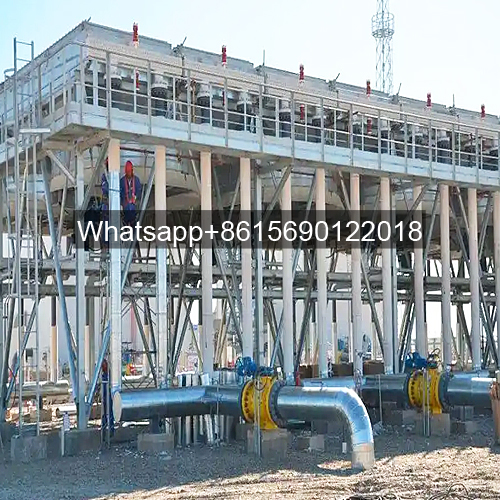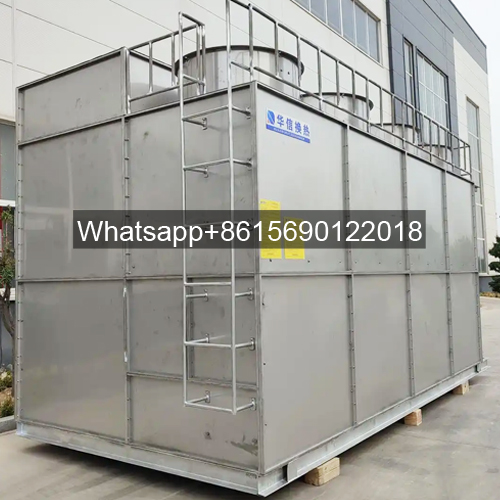I. Definition and Working Principle
Definition: A fin fan cooler, also known as a dry cooler or air cooler, uses ambient air as the cooling medium. This air passes across the exterior of finned tubes, cooling or condensing the high-temperature process fluid within the tubes.
Working Principle: It primarily uses air to dissipate heat within the pipes. By increasing the heat dissipation surface area of the internal finned tubes, the contact area between the air and the heat pipes increases, creating a physical exchange that dissipates heat and reduces temperature.

Fin Fan Cooler-Fin Fan Cooler Heat Exchanger-Air Cooled Heat Exchanger
Cooling Tower
Definition: A cooling tower is a device that cools water. The water exchanges heat and mass with the passing air, lowering the water temperature.
Working Principle: A cooling tower uses the contact between water and air to dissipate waste heat generated in industrial applications or refrigeration and air conditioning through evaporation. Specifically, dry, low-enthalpy air, pumped by a fan, enters the cooling tower, exchanging heat with the high-temperature water molecules flowing from the nozzles, gradually lowering the water temperature.
A fin fan cooler is a device whose primary function is to cool a fluid by transferring heat from the fluid to the surrounding environment. It is typically a closed system, cooling the fluid by circulating it through pipes.
A cooling tower, on the other hand, is a device used to cool water. It sprays water onto a filler material to form a film, utilizing the contact between the water and the air to transfer heat, thereby achieving the desired temperature reduction. Cooling towers are typically open systems.

II. Scope of Application and Fluid Handling
Fin Fan Cooler
Applicable Applications: Primarily suitable for environments with low ambient temperature and humidity, such as high altitudes. It is particularly suitable for handling toxic media that are explosive or soluble in water.
Maintenance Cost: Since no cooling water is required, maintenance costs are relatively low.
Cooling Tower:
Applicable Applications: Primarily suitable for environments with high ambient temperature and humidity, such as industrial areas and power plants.
Maintenance Cost: Since circulating cooling water is required, maintenance costs are higher.
Fin fan coolers are suitable for handling various types of fluids, such as oil and chemicals, and have a wide range of applications, often found in industrial processes such as boiler cooling and engine cooling.
Cooling towers, on the other hand, are primarily used for water treatment, particularly in large facilities like air conditioning systems, power plants, and chemical plants, where cooling needs are often met through cooling towers.
III. Structural Features and Floor Space
Fin Fan Cooler
Structural Types: Based on the tube bundle arrangement, they can be categorized as horizontal, vertical, circular, and sloping roof types; based on the air ventilation method, they can be categorized as natural draft, induced draft, and forced draft; and based on the cooling method, they can be categorized as wet, dry, and combined wet and dry types.
Cooling Tower:
Structural Type: A tower-shaped structure primarily used for heat exchange between water and air.
Fin fan coolers typically feature a compact design, a relatively simple structure, and a small footprint. This makes them particularly advantageous in environments with limited space.
Cooling towers, on the other hand, are more complex, typically consisting of a tower body, filler layer, and fan, and occupy a larger floor space. However, due to their efficient cooling performance, cooling towers are still widely used in large industrial facilities.
IV. Advantages, Disadvantages, and Energy Consumption
The main advantage of fin fan coolers is their enclosed design, which makes the fluid less susceptible to contamination and relatively simple to maintain. Coolers may require additional cooling media when handling high-temperature fluids, which increases energy consumption.
Cooling towers utilize the natural cooling capacity of water and air, resulting in relatively low energy consumption. However, their open design also makes the water susceptible to contamination and evaporation loss, requiring regular water replenishment and quality treatment.
V. Selection and Application Recommendations
In actual applications, the appropriate cooling equipment should be selected based on specific needs and scenarios. If non-aqueous fluids need to be handled or space is limited, a fin fan cooler may be a better choice.
In contrast, cooling towers offer advantages when large volumes of water need to be handled and energy consumption is a concern. Furthermore, with technological advancements, new cooling technologies, such as dry fin fan coolers, are emerging, providing more options for industrial production.
Although both Fin Fan Cooler and Cooling Tower are devices used to reduce heat, they have significant differences in definition, working principle, scope of application, advantages and disadvantages, etc. Therefore, comprehensive consideration should be made based on actual conditions when selecting and using them.
 dtfinnedtube.com
dtfinnedtube.com

